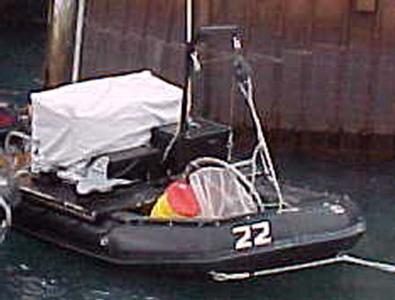9 April, 2000
LTER Krill Project
Question 50: What is the warmest temperature ever recorded in Antarctica?
Lowrider was the second LTER boat I was on. (See the journal from 3/19.)
Its researchers are working on the krill component of the LTER. This
component focuses on the effects of variation in the extent of pack ice and
food resources on macrozooplankton (macro- = large, zoo- = animal-like,
plankton = small organisms floating in the water). They are specifically
looking at production and recruitment of young krill and interactions among
krill, its food sources and its predators.
LTER work with krill is carried out on the annual research cruise as well as
throughout the entire summer season in the small-scale sampling area around
the station area. Sampling takes place all season except when the LTER
cruises are out, then no one is on station to do the near-shore surveys. The
cruises last 3-6 weeks.
The near-shore work integrates trawling for krill and bioacoustic surveys to
identify and measure schools of krill. Laurel and Andy, two of the
researchers working in the field this summer, run the two regular transects
(each approximately 3 miles long) once a week trying to quantify (get a
definite number for) krill abundance over time. By bouncing sound waves below
the boat, the instrumentation on Lowrider tells the dimensions and density of
a school. The rest of the time they take the boat out looking for krill
schools that are relatively large and dense to collect krill for lab work.
The survey work reveals patterns in timing of seasonal events and
physiological condition, growth and availability of krill. The collected
krill is used for growth experiments in the aquarium and for frozen specimens
to go back to the United States for further work. Usually, if they find a
large school on one of the standardized transects Andy and Laurel would not
stop to collect them as it biases the data if they stop moving. They have
done so only twice in this season. At that time, the krill collection was
more important for lab work pre- and post- cruise to compare to the krill work
done on the ship further out to sea.
There have been fewer krill schools around this summer than last summer.
Once Lowrider's crew finds some krill for collection, they use the trawling
net on the crane in the front of Lowrider to collect them. The net gets
pulled next to the boat and pulled in with the help of a winch. Once
collected, the krill must be kept in cold saltwater to maintain their
condition. When the krill are brought back to the lab, Laurel and Andy
measure weight, check maturity of krill, do spawning experiments, and examine
growth rate. They are looking at basic population dynamics, trying to gauge
how healthy the population is.
In addition to surveys and trawls, in the early part of the summer season,
SCUBA divers collected young krill from under the ice and conducted ice
surveys with an underwater digital video camera to document the density of
krill and feeding behavior. Undersea ice space is important for the krill
because that is where the juveniles feed on algae. Adult krill could take
advantage of the algal resource too, but for adults there is a greater threat
of predation under the ice. The undersea ice algae is necessary for the
survival of a healthy population of juvenile krill. It is not as important
for adults. Juvenile krill are around 20-25 mm in length, adults around 50
mm.
Krill is an important part of the LTER because it forms a pivotal link in the
food chain in the Antarctic. They convert all the energy in the plankton
(both zooplankton and phytoplankton) and make the energy available to higher
trophic levels. Most consumers (birds, seals, whales, etc.) here exploit
krill either directly or indirectly.
The LTER research hasn't identified any long-term trends in the overall
krill population yet, but the evidence shows that fluctuations in the krill
population are correlated to the ice coverage. It is reasonable to assume
that changes in global climate that affect ice coverage would also affect the
krill population. The krill surveys have been done during every year of the
LTER creating a vast data set for future analysis.
This is Andy's first season, he has been here for five months. Laurel was on
the LTER's cruise last year and returned to see what station life was like.
She arrived in January and left at the end of March. While both would like
to come back to Palmer station sometime, they will probably not have the
opportunity to do so with the LTER. Andy starts working towards his Masters
degree in Marine Biology this fall, and Laurel plans to attend veterinary
school.
Their favorite part of being in Antarctica is the breathtaking scenery and
wildlife. Their main frustration has been the lack of krill! Andy says that
the hardest part about working here for a long time is the repetitiveness of
work, the isolated location (same rocks, same people), no vacation time, and
missed holidays. They are both very much looking forward to seeing their
families again.
We are still not diving--today due to windy weather and rain.
Answer 49: No, fossils of sequoia, fig and beech trees, tree ferns, small
marsupials, and even dinosaurs have been found in Antarctica, showing that the
continent was once covered with forests.

View along survey transect 1 from station E. Anvers Island is in the distance.

Lowrider approaching (you can see how it got its name).

Computer display and paper print out showing topography of sea floor on the transect.

Lowrider's bow with crane and winch for krill trawling net. Kermit is also visible, attached on the side.

Krill sorted by size (and therefore by age).

Contact the TEA in the field at
.
If you cannot connect through your browser, copy the
TEA's e-mail address in the "To:" line of
your favorite e-mail package.
|
